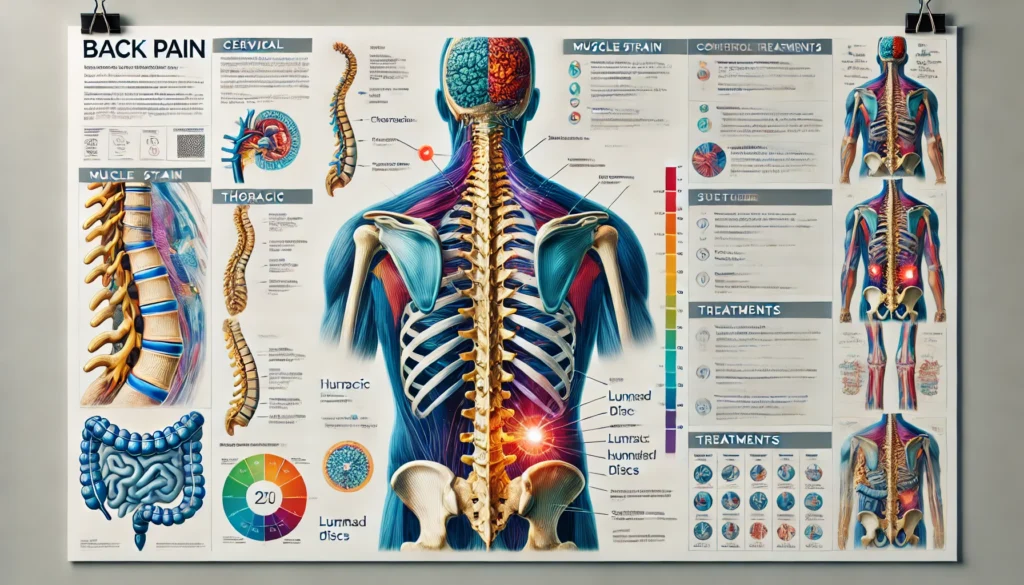Whether it’s a dull ache, sharp pain, or discomfort that radiates down the legs, back pain can significantly impact your daily life. Understanding where your pain is coming from is the first step in finding relief. A back pain chart can be a valuable tool for identifying the source of your discomfort, helping you communicate more effectively with your healthcare provider, and guiding you toward the right treatment.
In this article, we’ll explore the different types of back pain, explain how to interpret a back pain chart, and provide insights into common causes of back pain by location.
1. What Is a Back Pain Chart?
A back pain chart is a visual representation that helps individuals identify the location and type of pain they’re experiencing in the back. It provides a detailed breakdown of common areas where pain can occur, such as the upper, middle, and lower back, along with specific regions like the neck and pelvis.
These charts often come with illustrations that highlight pain areas and may include color-coded sections to represent different types of discomfort (e.g., sharp, dull, burning, etc.). By understanding where your pain occurs, you can better pinpoint the underlying cause and seek the appropriate treatment.
Read Also: Back Hurts After Eating – Upper or Lower Back Pain Following Eating!
2. Types of Back Pain and Their Locations
Back pain can vary greatly in intensity, duration, and cause. Using a back pain chart can help you better understand the nature of your pain. Here’s a breakdown of common types of back pain based on location:
Upper Back Pain (Thoracic Spine)
- Symptoms: Pain in the upper back can feel like tightness, stiffness, or sharp discomfort. It may also radiate to the shoulders or neck.
- Common Causes: Poor posture, muscle strain, herniated discs, and stress.
Middle Back Pain
- Symptoms: A deep, aching sensation or sharp pain in the middle region of your back.
- Common Causes: Degenerative disc disease, muscle strain, or spinal misalignment.
Lower Back Pain (Lumbar Spine)
- Symptoms: Often described as a deep ache, stabbing, or radiating pain that may travel down to the legs.
- Common Causes: Herniated discs, sciatica, muscle strain, arthritis, or spinal stenosis.
Neck Pain (Cervical Spine)
- Symptoms: Neck pain can be sharp, dull, or accompanied by stiffness. It may radiate to the shoulders or upper back.
- Common Causes: Whiplash, poor posture, arthritis, or herniated discs.
3. Back Pain Chart: Identifying Common Causes by Location

A detailed back pain chart can help you identify the underlying cause of your discomfort. Here are some of the most common causes of pain in specific areas of the back:
Neck and Upper Back Pain
- Poor posture: Sitting or standing incorrectly for long periods can strain the muscles and joints in the upper back.
- Muscle strain: Overexertion from lifting heavy objects or sudden movements can lead to muscle tension.
- Cervical disc herniation: A slipped disc in the neck region can compress nerves, causing pain that may radiate to the arms and shoulders.
Middle Back Pain
- Spinal misalignment: Misalignment of the vertebrae can cause discomfort and limited mobility.
- Degenerative disc disease: As discs wear out over time, they can press on nearby nerves, leading to pain.
Lower Back Pain
- Herniated discs: When a disc bulges or ruptures, it can irritate the nerves, causing intense lower back pain that may radiate to the legs (sciatica).
- Spinal stenosis: Narrowing of the spinal canal can put pressure on nerves, resulting in pain, numbness, or weakness.
- Spondylolisthesis: This condition occurs when one vertebra slips over another, causing back pain and instability.
4. How to Use a Back Pain Chart
Using a back pain chart is simple and can help you communicate more effectively with your healthcare provider. Here’s how to use it:
- Locate the area of your pain: Use the chart to identify the area where you’re experiencing pain. You may notice that your pain corresponds to a particular region of the back, such as the upper back or lower back.
- Identify the type of pain: Pay attention to the nature of your pain. Is it sharp, dull, burning, or throbbing? The chart may indicate what types of pain are associated with specific conditions.
- Note any radiating pain: Sometimes, back pain can travel down the legs or into the arms. Be sure to note if your pain radiates, as this can help in diagnosing conditions like sciatica.
- Consult your healthcare provider: With the back pain chart as a reference, discuss your symptoms with your doctor or physical therapist. The chart can help them better understand your pain and recommend the most appropriate treatment plan.
5. Common Treatments for Back Pain Based on Your Chart
Once you’ve identified the area and type of your back pain, the next step is exploring treatment options. Here are some general treatments for common back pain issues:
- Physical therapy: Targeted exercises can help strengthen muscles and improve posture, alleviating pain.
- Chiropractic care: Spinal manipulation may help with alignment issues and provide relief for certain types of back pain.
- Medications: Nonsteroidal anti-inflammatory drugs (NSAIDs), muscle relaxants, or prescription pain relievers can help manage discomfort.
- Heat and cold therapy: Applying heat or cold packs can reduce inflammation and ease muscle tension.
6. When to Seek Medical Help
While most back pain can be managed with self-care and basic treatment, certain signs may indicate a more serious underlying issue. Seek medical attention if:
- Your pain is severe and doesn’t improve with rest.
- You experience numbness or tingling in your legs or arms.
- You have difficulty controlling your bladder or bowels.
- You experience unexplained weight loss or fever alongside back pain.
FAQs:
1 What is a back pain chart?
A back pain chart is a visual representation that helps identify the location and type of back pain, aiding in diagnosis and treatment.
2 How can a back pain chart help me?
It helps pinpoint where the pain is located, which can lead to a more accurate diagnosis and appropriate treatment plan.
3 What causes upper back pain?
Upper back pain can be caused by poor posture, muscle strain, or conditions like herniated discs.
4 When should I seek medical help for back pain?
Seek medical help if the pain is severe, persistent, or accompanied by numbness, tingling, or loss of bowel/bladder control.
5 Can a back pain chart help with sciatica?
Yes, a back pain chart can help identify symptoms of sciatica, such as radiating pain down the legs, aiding in diagnosis and treatment options.
Conclusion:
A back pain chart is an essential tool for understanding where your pain is coming from and what might be causing it. By identifying the area, type, and intensity of your pain, you can make more informed decisions about your treatment options and communicate effectively with healthcare providers.If your back pain persists or worsens, don’t hesitate to seek medical advice. Early intervention can help prevent further damage and get you back to living pain-free.
Read More Relevant Article:
- Read Also: Upper Back Hurts When I Breathe – Pain in the Upper Back with Deep Breaths!
- Read Also: Lower Back Pain in the Morning That Goes Away – Morning Lower Back Pain That Disappears After a While!
- Read Also: Gastritis Symptoms and Back Pain – Signs of Gastritis and Their Connection to Back Pain!











